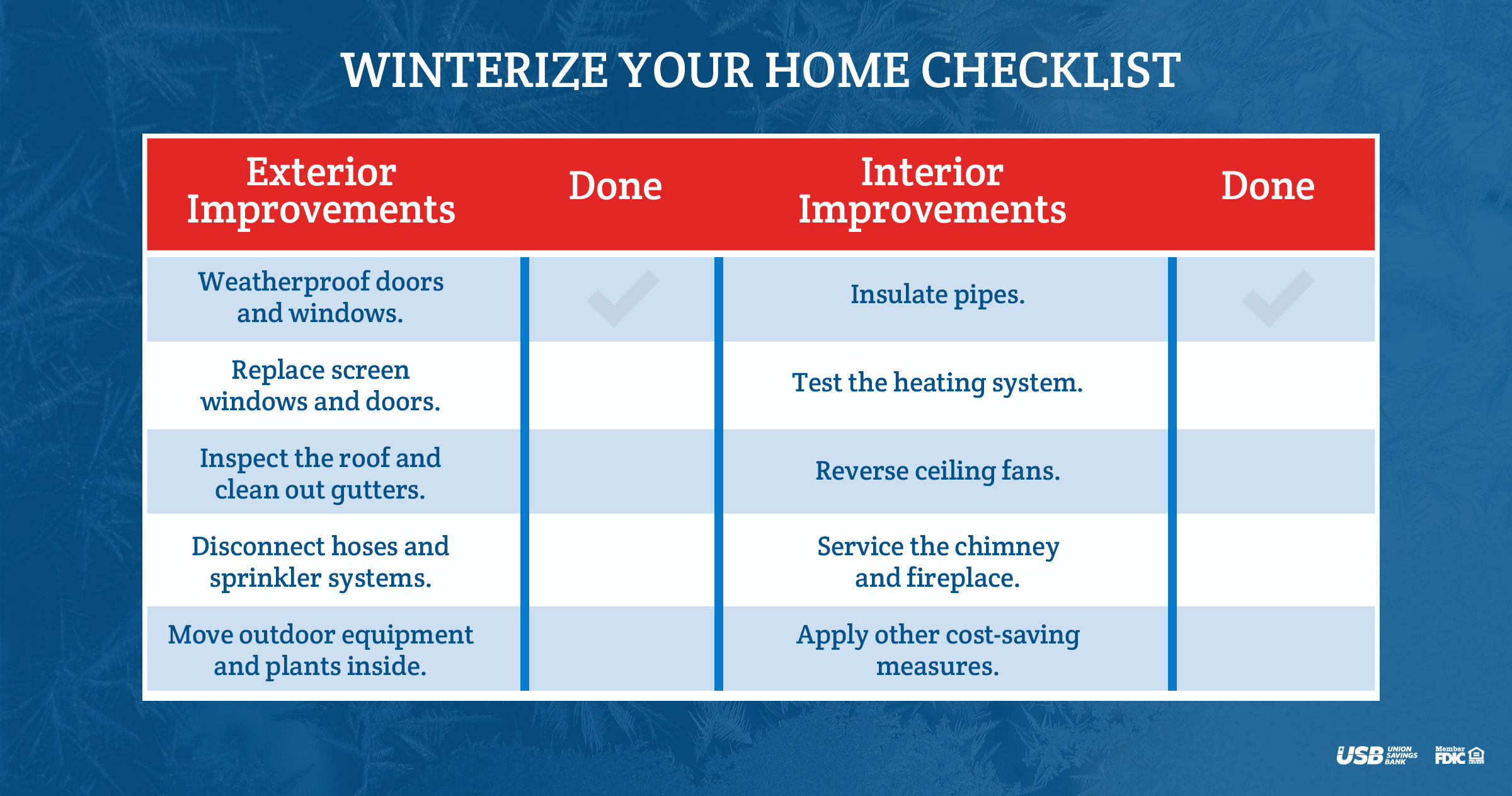Winterize-Your-Home Checklist
Cooler temperatures mean higher bills from turning the heat on to stay warm. Winterizing your home can help you save money while protecting your home from the harsh winter elements and, in turn, minimize the maintenance work you must do in the spring. It’s also essential if you’re selling your home during the winter months.
When is the best time to winterize your home?
It might seem straightforward, but you should start to winterize your home before winter weather arrives. You want to be prepared for cold temperatures, not caught off guard by them. Nobody wants to work on a home’s exterior in sub-freezing temperatures.

Exterior Improvements
1. Weatherproof doors and windows.
Doors and windows are the largest offenders allowing drafts into your home. There are a few simple tips to fix unwanted air leaks. Door thresholds are an easy way to prevent cold airflow from coming through the bottom of doors or windows. They can be bought or handmade at home.
For a more permanent solution, buy double-pane windows to eliminate drafts and increase energy efficiency or install insulation inside the window frames. Sealing windows and doors with caulk or using weatherproof strips around cracks can also help prevent leaks.
2. Replace screen windows and doors.
Screen windows and doors can get damaged easily. You can replace any screen windows and doors around your home with storm windows and doors. These will provide an extra layer of insulation, helping to reduce your heating bill.
3. Inspect the roof and clean out gutters.
Scheduling a roof inspection in the winter is difficult, especially if you live in an area with heavy precipitation. Be proactive and hire a professional to examine the roof and gutters in the summer or fall to find any problems like missing shingles or clogs. If you discover any issues, you have time to make fixes on your own or hire help.
4. Disconnect hoses and sprinkler systems.
Sprinkler systems can freeze and burst in freezing temperatures. The easiest way to winterize the system is by shutting off the water supply and draining the water in the fall when you’re ready to stop landscaping.
Be sure to disconnect garden hoses and shut off water to those sources (like an outdoor faucet). If you own a pool, drain and cover it for the winter.
5. Move outdoor equipment and plants inside.
Bring inside anything that could be damaged by freezing temperatures or snow. Store outdoor furniture inside. Clean, disconnect, and cover gas grills. Add mulch around outdoor plants to protect their roots and bring small potted plants inside. When light freezes are coming, you can cover plants with blankets overnight and uncover them during the day.
Interior Improvements
6. Insulate pipes.
Pipes aren’t fragile but are susceptible to damage. Frozen pipes can cause leaks, which can lead to water damage. Even if you don’t live somewhere consistently below freezing during the winter, keep pipes insulated—especially unprotected ones in the attic or garage.
Newspaper or pipe sleeves from a hardware store can temporarily prevent pipes from freezing or bursting when the temperature drops. If you’re leaving for an extended period, consider turning the water off completely. More permanent solutions are also available for exposed pipes, but work with a professional rather than doing it on your own.
7. Test the heating system.
Nobody wants to discover that the heat isn’t working when they turn on the furnace during the first freeze. Test the heat toward the end of October to ensure warm air is blowing. If something seems amiss or the system is old, hire a professional to make sure everything’s in working order. You may also want to protect the hot water heater using an insulated blanket purchased from a hardware store.
In addition to testing the heater, replace the air filters and clean the ducts in your home. To do this safely, turn off the heating system, unscrew the duct covers, and vacuum them as thoroughly as possible. This is also a great time to check the carbon monoxide detector.
8. Reverse ceiling fans.
One of the easiest ways to lower heating costs during the winter months is to set your ceiling fans to rotate in a clockwise direction to push warm air near the ceiling down into the room.
9. Service the chimney and fireplace.
Schedule an inspection for your chimney before you use it to ensure it’s safe. Similarly, you may want to test smoke detectors and install fresh batteries.
If you don’t use the fireplace in the winter, seal it up to keep warm air from escaping through the chimney. Many fireplaces have a flue that makes it easy to seal the chimney. Install glass doors around the fireplace opening to reduce heat loss and keep out cold air.
10. Apply other cost-saving measures.
Lastly, you can do many little things to save money on your energy bill throughout the winter. Adjusting day-to-day habits can make the winter less of a burden on your wallet without harming your home or tolerating discomfort.
- Install hot-water-saving showerheads and faucet aerators.
- Consider keeping the hot water heater and thermostat at a consistent temperature, and don’t adjust them often during the winter.
- Unplug appliances when you’re not using them.
- Turn off lights when you’re not in a room.
- Fit light fixtures with LED light bulbs.

NMLS# 446047


